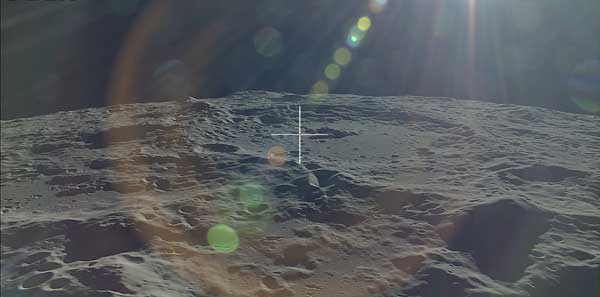
TUCSON, Ariz. (University of Arizona PR) — The presumed SpaceX Falcon 9 rocket booster that’s on a course to hit the moon March 4 is actually a Chinese booster from a rocket launch in 2014, a University of Arizona team has confirmed.
UArizona students in the university’s Space Domain Awareness lab at the Lunar and Planetary Laboratory have had their eyes on the piece of space junk for weeks as they studied its rotation. They have been gathering other data as well, which they used to confirm its Chinese origin.
“We took a spectrum (which can reveal the material makeup of an object) and compared it with Chinese and SpaceX rockets of similar types, and it matches the Chinese rocket,” said UArizona associate professor Vishnu Reddy, who co-leads the Space Domain Awareness lab with ngineering professor Roberto Furfaro. “This is the best match, and we have the best possible evidence at this point.”
Reddy and his students are providing observations to NASA’s Jet Propulsion Laboratory to help pinpoint the location of the booster’s upcoming impact on the moon, which could be imaged and verified by NASA’s Lunar Reconnaissance Orbiter.
They estimate that it will hit somewhere in or near the Hertzsprung crater on the moon’s far side. UArizona is the only public university that has a dedicated academic program for space domain awareness. UArizona’s space science program was ranked No. 2 among public U.S. universities and No. 10 in the world in U.S. News & World Report’s 2021 Best Global Universities rankings.
Based on its path through the sky, the booster was initially thought to be a SpaceX Falcon 9 rocket booster from a 2015 launch, with a trajectory that put it on a path to hit the moon. The unintentional impact of space junk on the moon is uncommon. But the rocket is now believed to be a booster for the Chang’e 5-T1, launched in 2014 as part of the Chinese space agency’s lunar exploration program.
Using the RAPTORS system, a telescope atop the Kuiper Space Sciences building on campus, UArizona students took observations on the nights of Jan. 21 and Feb. 7, the latter of which was the last time the rocket would be visible before it hits the moon in March.
“I am astounded that we can tell the difference between the two rocket body options – SpaceX versus Chinese – and confirm which one will impact the moon with the data we have. The differences we see are primarily due to type of paint used by SpaceX and the Chinese,” said Adam Battle, a graduate student studying planetary science. Battle has worked at the Space Domain Awareness lab since 2018 and focuses on spectroscopy, which helped confirm the booster’s origins. An object’s spectrum can also reveal the effects of space weathering.
“We don’t often get a chance to track something we know is going to hit the moon ahead of time,” said Tanner Campbell, an aerospace and mechanical engineering graduate student who has worked with Reddy since 2017. “There is particular interest in seeing how impacts produce craters. It’s also interesting from an orbital prediction perspective, because it’s traveling between the Earth and moon unpropelled. It’s just an inert rocket body tossed around by its own energy and by solar radiation pressure, so we can evaluate our models and see how good our predictions are.”
Campbell focused on photometry of the object, meaning he determined how fast it spins. Rocket bodies have a distinct pattern of brightness that makes them easily identifiable.
This booster is just one of many pieces of space junk that the UArizona team and others around the world are tracking. There are roughly 3,500 active satellites orbiting Earth, and another 20,000 pieces of debris or space junk, according to Reddy. There is significantly less space debris surrounding the moon, however.
“While this isn’t the most detrimental impact, the idea of so many objects in space with unknown orbits and identities is worrying,” said Grace Halferty, an undergraduate student double majoring in mechanical engineering and biology. She has, since September 2018, been studying SpaceX’s Starlink satellites and their effect on ground-based astronomy. “We need better space traffic management.”
“There are only a handful of objects in lunar orbit,” Reddy said, “but I hope this event sheds light on the growing problem of space junk. This science community is concerned about the growing pollution.”
The UArizona team has also tracked and identified many other humanmade objects as they travel across the sky.
- In 2018, the UArizona team used a $1,500 optical sensor they built in four months to track the defunct Chinese space station Tiangong-1 before it fell into the sea on March 31.
- In 2020, the team tracked a piece of an Atlas rocket that launched Surveyor 2 in 1966. Using spectroscopy, the team confirmed that it was what’s called the “Centaur upper stage” – the part of the rocket that provides the in-space thrust to set the spacecraft on a precise trajectory toward the moon.
- In 2021, the team tracked the 22-ton Long March 5B rocket that launched China’s Tianhe space station module into Earth’s orbit before the rocket fell to Earth on May 8.
– Advertisement –